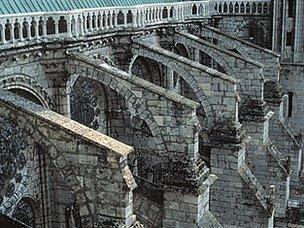The Mars sensor inspired by lobsters and cathedrals
- Published

The micro-seismometer is little bigger than a £1 coin
Nasa's next mission to the Martian surface will be carrying a UK-built device not much bigger - and much lighter - than a £1 coin.
The micro-seismometer to be carried by the Mars InSight mission, set to launch in 2016, external, is the pride and joy of Prof Tom Pike, of Imperial College London.
Sat in his small, campus office, he puts on some purple latex gloves and picks up an example of the seismometer from a Petri dish.
He urges me to listen - so I can hear it quietly ringing as it oscillates in his hand. It's made of silicon, like microchips, but it's a mechanical, not an electrical device, hewn from a single silicon crystal and able to detect the tiniest movements.

Flying buttresses, used to strengthen medieval cathedrals, inspired the seismometer's design
Once on Mars, two of these seismometers - to measure horizontal and vertical movements respectively - will be used to detect "marsquakes" - earthquakes on the Red Planet.
It's hoped these movements will tell us more about the planet's inner workings and provide more evidence of how Mars was formed and evolved.
The seismometer's design, Prof Pike says, draws on nature and medieval architecture.
Its "proof mass" - the bit that moves - is held by pincers inspired by the lobster claw.
And these pincers connect to arms in the shape of flying buttresses, which support the structure much in the same way they were used to strengthen medieval cathedrals.
"Our design is defined by the mathematics," Prof Pike says. "The medieval architects came to that solution though trial and error, but they came to a very well optimised solution to make their cathedrals as strong as possible."
Professor Tom Pike of Imperial College London talks about the micro seismometer he and his team have designed
InSight, which stands for Interior Exploration using Seismic Investigations, Geodesy and Heat Transport, will study the deep interior of Mars to better understand the processes that shaped the rocky planets of the inner solar system, including Earth, more than four billion years ago.
Besides the seismometers built by the Imperial team and another by the French Space Agency, the lander will also carry a German heat-flow probe, which will hammer down up to 5m (16ft) into the Martian surface, and a magnetometer to detect magnetic fluctuations in the planet's upper atmosphere.
A device built by Nasa's Jet Propulsion Laboratory will measure the rotation of the planet.
The mission team will use these instruments to probe the Martian layers right down to its core.
"We can't be sure there's plate tectonics on Mars - probably not," says Prof Pike. "It's just not quite large enough a planet, and it's probably cooled down a little too much, so that's one thing which we want to determine.
"The other difference compared to the Earth is that Mars has lost its magnetic field, and that has a really important influence on protecting us on Earth from the solar wind, from radiation.
"We'd like to find out whether there are still remnants of a solid core or a liquid core which give us some indication of how the planet itself evolved."
The design of the probe and its landing mechanism are similar to the successful Phoenix probe, which landed on Mars in 2008. The craft, which carried a microscope developed by Prof Pike, was the first lander to directly detect water ice in the Martian surface.
But while Phoenix landed near the northern ice cap of the planet, InSight will land near the equator.
InSight will be Prof Pike's second mission to Mars, with a potential third already lined up - his team is set to build another microscope for Nasa's Mars 2020 rover mission.
- Published12 October 2013
- Published21 August 2012
